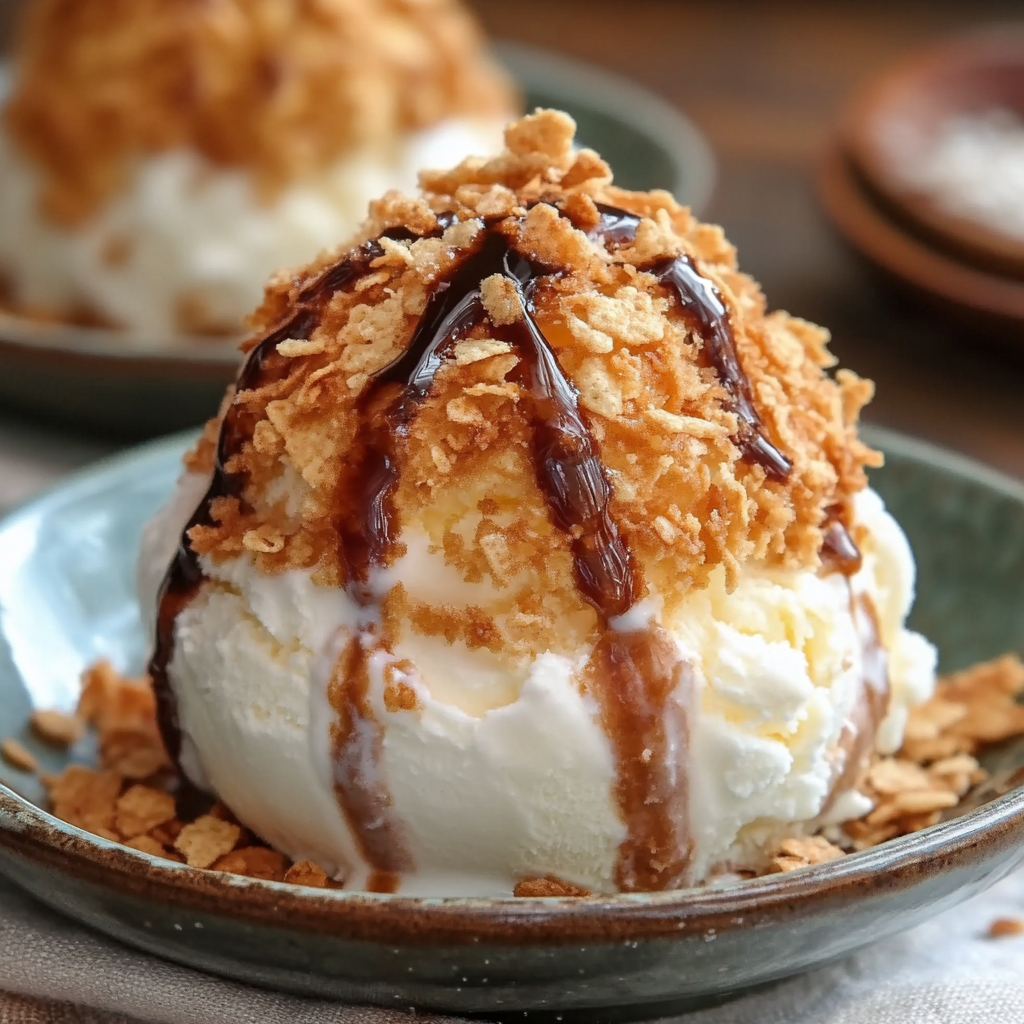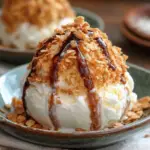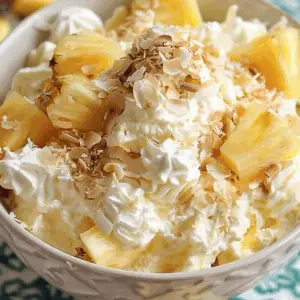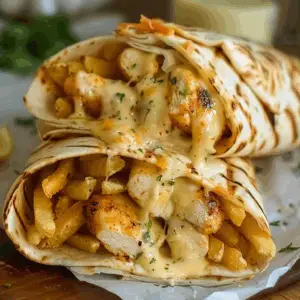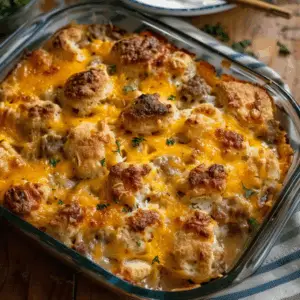Mexican Fried Ice Cream is a one-of-a-kind dessert that combines the best of both worlds—crispy, golden crunch on the outside and cold, creamy ice cream on the inside. This mouthwatering treat is often found in Mexican restaurants and Tex-Mex establishments, where it’s served as a show-stopping finale to a delicious meal.
Despite its name, Mexican Fried Ice Cream isn’t exclusively a Mexican dessert. While it’s widely associated with Mexican cuisine, its exact origins are debated. Some sources suggest it was first introduced in the United States at fairs and carnivals, while others claim that Asian cultures were frying ice cream long before it became popular in Mexican restaurants.
The appeal of this dessert lies in its contrasting textures and flavors. A frozen scoop of vanilla ice cream is coated in a crispy mixture—typically made from crushed cornflakes, cinnamon, and sugar—before being flash-fried to golden perfection. The frying process is so quick that the ice cream inside remains frozen, creating a delicious balance of hot and cold, crunchy and creamy.
This unique dessert is often drizzled with honey or chocolate syrup and topped with whipped cream and a maraschino cherry, making it visually appealing and utterly indulgent. Whether enjoyed at a restaurant or made at home, Mexican Fried Ice Cream is a must-try treat for anyone with a sweet tooth.
One of the fascinating aspects of this dessert is its preparation. While many assume that deep-frying ice cream is complicated, it’s actually quite simple when done correctly. The key lies in properly freezing the ice cream and using the right coating to protect it from melting too quickly. Learning how to make this dessert at home can be a fun and rewarding experience.
For those interested in the science behind frying desserts, the process follows the same principles as other deep-fried treats. According to Wikipedia: Deep Frying, rapid frying at high temperatures seals the outer layer quickly, preventing the inner contents from melting. This explains why Mexican Fried Ice Cream can maintain its frozen core even after being briefly submerged in hot oil.
Additionally, fried ice cream has variations across different cultures. While Mexican Fried Ice Cream is coated in cornflakes, other versions use panko breadcrumbs, crushed cookies, or even shredded coconut. Each variation adds a distinct texture and flavor to the dessert, making it versatile and adaptable to different preferences.
If you’re a fan of traditional Mexican sweets, you might also enjoy exploring other deep-fried treats from this cuisine. Wikipedia: Mexican Candy highlights the rich history of Mexican confections, many of which feature similar ingredients like cinnamon, sugar, and crunchy coatings.
This introduction sets the stage for diving deeper into the history, ingredients, and step-by-step process of making Mexican Fried Ice Cream. Whether you’re a home cook looking to impress guests or simply a dessert lover eager to try something new, this guide will walk you through everything you need to know about this beloved treat.
History and Origins of Fried Ice Cream
The origins of fried ice cream have been widely debated, with multiple cultures claiming to have invented this unique dessert. While it is commonly associated with Mexican cuisine, its history suggests a more complex background that spans across Asian, American, and European influences.
One of the earliest records of fried ice cream dates back to the 1893 Chicago World’s Fair, where it was introduced as a novelty treat. However, some sources argue that a similar dish had already been enjoyed in Asian countries for centuries. In Japanese cuisine, a variation known as tempura-fried ice cream has long been popular, using a light and airy batter to encase the ice cream before frying.
The dish also found its way into Chinese-American restaurants, where it was commonly served as a dessert alongside traditional meals. Many believe that fried ice cream became a staple in the U.S. during the 20th century, thanks to its presence in Chinese and Japanese eateries. According to Wikipedia: Fried Ice Cream, the dessert gained mainstream popularity in America in the 1980s, particularly in Mexican-style restaurants.
How Did Fried Ice Cream Become a Mexican Dessert?
Despite its broader history, fried ice cream is most commonly associated with Mexican cuisine today. This connection is largely due to the efforts of restaurant chains like Chi-Chi’s, a Tex-Mex chain in the United States that popularized the dessert in the 1980s. They marketed fried ice cream as an authentic Mexican treat, leading many to associate it with traditional Mexican desserts.
Additionally, the ingredients used in Mexican Fried Ice Cream—such as cinnamon, sugar, and cornflakes—are commonly found in Mexican sweets. These flavors closely resemble traditional desserts like churros and buñuelos, which are also deep-fried and coated with cinnamon sugar. This similarity further reinforced the connection between fried ice cream and Mexican cuisine.
Another possible link to Mexican culinary traditions is the use of honey and chocolate syrup as toppings. These ingredients are staples in many Mexican desserts, including churros and flan. For those interested in traditional Mexican sweets, Wikipedia: Mexican Cuisine provides a deeper look into the country’s rich dessert culture.
Cultural Variations of Fried Ice Cream
While Mexican Fried Ice Cream remains one of the most well-known versions, other cultures have put their own spin on the dessert:
- Japan: Tempura-fried ice cream uses a light, crispy batter rather than a cereal-based coating.
- China: Some Chinese-American restaurants serve a variation using panko breadcrumbs instead of cornflakes.
- Thailand: In Thai street markets, vendors make rolled ice cream with similar flavors, though it isn’t deep-fried.
- Italy: Gelato fritto is a variation where Italian gelato is coated in breadcrumbs and flash-fried.
These international variations highlight how fried ice cream has evolved over time, adapting to different culinary traditions while maintaining its signature contrast of crispy and cold textures.
The Evolution of Fried Ice Cream Over Time
As the dessert spread globally, different methods of preparation emerged. Some modern recipes avoid deep-frying altogether, opting for baked or air-fried versions to achieve a similar crispy texture. Others experiment with unique coatings like graham crackers, crushed Oreos, or even shredded coconut.
In recent years, fried ice cream has also gained popularity in social media trends. Platforms like Pinterest: Fried Ice Cream Recipes showcase creative twists on the classic dessert, inspiring home bakers to try new variations. From chocolate-dipped to caramel-drizzled versions, the possibilities are endless.
The history of fried ice cream proves that while it may not have originated in Mexico, it has undoubtedly found a lasting place in Mexican cuisine. Whether you enjoy it at a restaurant or make it at home, this crispy, creamy delight continues to be a beloved treat worldwide.
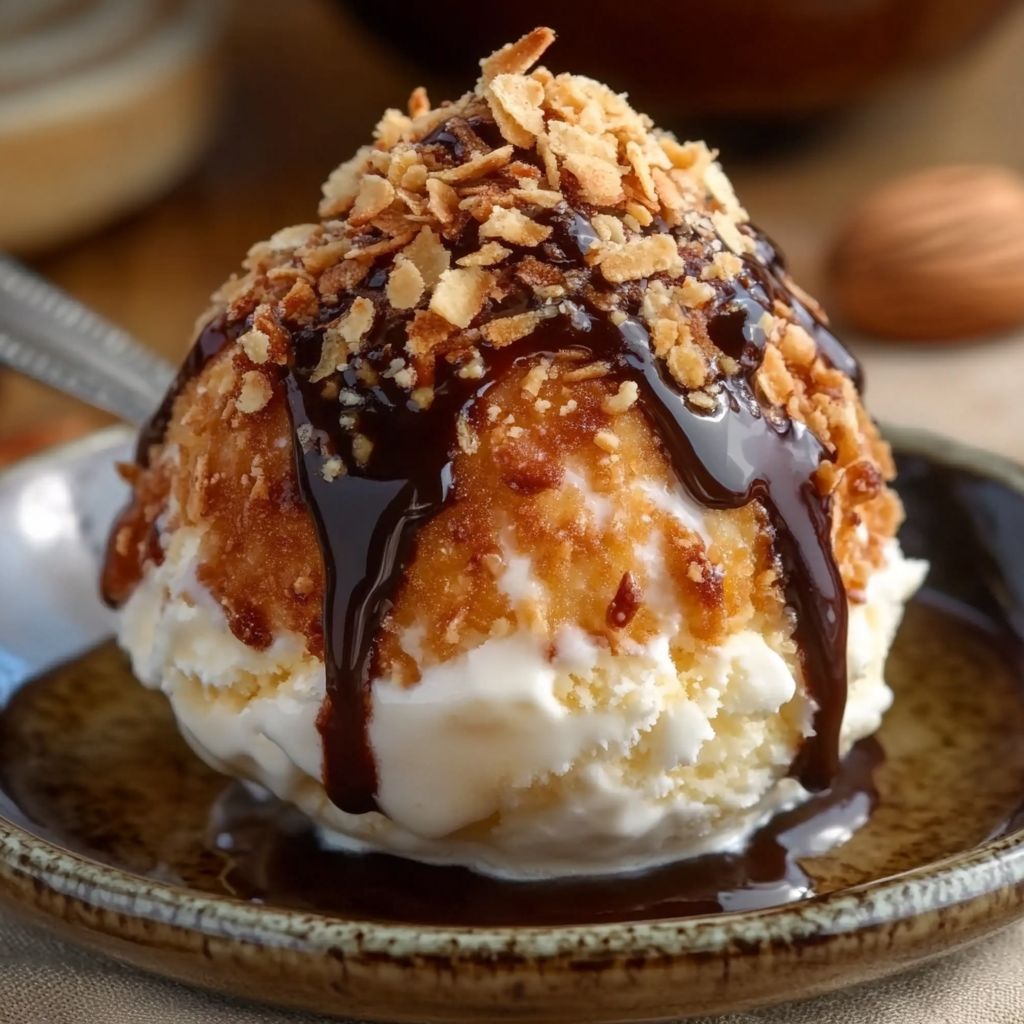
Ingredients Breakdown
Understanding the key ingredients in Mexican Fried Ice Cream is essential for achieving the perfect balance of crispy, golden coating and cold, creamy center. Each component plays a crucial role in creating this irresistible dessert.
Ice Cream: The Heart of the Dessert
The foundation of fried ice cream is, of course, the ice cream itself. While vanilla ice cream is the traditional choice, you can experiment with other flavors to add variety. Some popular alternatives include:
- Chocolate: For a richer, more indulgent taste.
- Strawberry: Adds a fruity twist that pairs well with honey or whipped cream.
- Caramel Swirl: Enhances the dessert’s sweetness with deep, buttery notes.
Since the ice cream needs to withstand brief deep-frying, choosing a high-quality, full-fat ice cream is crucial. Lower-fat varieties tend to melt too quickly, making it difficult to achieve the desired contrast between hot and cold textures.
For those interested in how different ice creams are made, Wikipedia: Ice Cream provides insights into the science behind this frozen treat.
Cornflakes: The Secret to the Crunchy Coating
A defining feature of Mexican Fried Ice Cream is its crunchy outer layer, typically made with crushed cornflakes. This coating serves multiple purposes:
- Adds a crispy texture that contrasts with the smooth ice cream.
- Creates a protective barrier to prevent the ice cream from melting during frying.
- Absorbs flavors from cinnamon and sugar, enhancing the overall taste.
For best results, it’s important to:
✔ Use finely crushed cornflakes for even coverage.
✔ Press the coating firmly onto the ice cream to create a solid crust.
✔ Double-coat the ice cream for extra crunch.
While cornflakes are the classic choice, you can also experiment with alternative coatings:
- Graham crackers – Adds a slightly sweet, cookie-like crunch.
- Oreo crumbs – Perfect for chocolate lovers.
- Shredded coconut – Gives a tropical twist to the dish.
Wikipedia: Mexican Candy explores similar ingredients found in traditional Mexican sweets, many of which feature crunchy textures like fried ice cream.
Cinnamon & Sugar: The Flavor Boosters
The combination of cinnamon and sugar gives Mexican Fried Ice Cream its signature warm, sweet-spiced flavor.
- Cinnamon adds a subtle heat and aromatic depth.
- Granulated sugar provides sweetness and helps caramelize the coating slightly.
This blend mimics the flavors of classic Mexican desserts like churros and buñuelos, both of which are known for their cinnamon-sugar coatings.
For an extra kick, some recipes incorporate nutmeg or cayenne pepper, adding a mild heat that complements the sweetness.
Vegetable Oil: The Key to Quick Frying
Since the frying process is extremely quick (just 5-10 seconds), choosing the right oil is essential. The best options for frying ice cream include:
✔ Vegetable oil – A neutral flavor and high smoke point.
✔ Canola oil – Slightly lighter than vegetable oil, great for frying desserts.
✔ Peanut oil – Provides a slightly nutty taste, but not ideal for those with allergies.
The oil should be heated to 375°F (190°C) to ensure the outer coating crisps up instantly while keeping the ice cream frozen.
For more information on deep-frying techniques, Wikipedia: Deep Frying explains the science behind this cooking method.
Toppings: The Final Touch
Once fried, Mexican Fried Ice Cream is traditionally topped with honey or chocolate syrup, followed by whipped cream and a maraschino cherry. These toppings not only enhance the flavor but also add a visually appealing finishing touch.
Other delicious topping options include:
- Caramel drizzle – For a buttery, sweet finish.
- Chopped nuts – Adds extra crunch and nuttiness.
- Fresh berries – Balances the sweetness with a hint of tartness.
- Sprinkles – Perfect for a fun, colorful presentation.
For more creative topping ideas, check out Pinterest: Ice Cream Toppings.
By carefully selecting and combining these ingredients, you can create an authentic and delicious Mexican Fried Ice Cream that’s sure to impress!
Equipment Needed
To make Mexican Fried Ice Cream successfully, having the right equipment is just as important as using the best ingredients. Proper tools ensure the ice cream remains frozen, the coating stays crisp, and the frying process is quick and efficient. Here’s everything you need to prepare this indulgent dessert.
1. Baking Sheet: Essential for Freezing
A baking sheet is crucial for the freezing process, as it provides a flat surface to hold the ice cream balls while they firm up. Proper freezing ensures the ice cream retains its shape during coating and frying.
✔ Use a non-stick or parchment-lined baking sheet to prevent sticking.
✔ Space out the ice cream scoops so they don’t freeze together.
✔ Freeze for at least 1 hour before coating to achieve a firm texture.
This step is key to preventing the ice cream from melting too quickly when fried. If you’re interested in learning more about ice cream preservation, Wikipedia: Ice Cream provides insights into the freezing process.
2. Mixing Bowls: For the Coating Mixture
You’ll need at least two mixing bowls:
- One for the crushed cornflakes, cinnamon, and sugar mixture.
- Another for dipping and rolling the ice cream balls.
✔ Use a deep bowl to evenly coat the ice cream without making a mess.
✔ Crush the cornflakes finely to ensure a smooth and even coating.
For alternative coating ideas like graham crackers or Oreos, check out Pinterest: Ice Cream Toppings for creative inspirations.
3. Deep Fryer or Deep Pan: For Quick Frying
A deep fryer or a deep, heavy-bottomed pan is needed to fry the ice cream quickly without allowing it to melt. The key factors to consider when choosing a frying vessel include:
✔ Depth: The oil should be deep enough to fully submerge the ice cream balls.
✔ Material: Use cast iron or stainless steel for even heat distribution.
✔ Size: A medium-sized pot works best to prevent oil from splashing.
Frying must be done at precisely 375°F (190°C) to ensure a crispy coating while keeping the ice cream frozen. Using a kitchen thermometer can help maintain the correct temperature. For a deeper look into frying techniques, Wikipedia: Deep Frying explains the science behind this method.
4. Slotted Spoon: For Safe Handling
A slotted spoon is essential for carefully lowering the coated ice cream into the hot oil and removing it quickly without damaging the crispy coating.
✔ Use a heat-resistant spoon to avoid burns.
✔ Drain excess oil immediately to maintain a crisp texture.
5. Paper Towels: For Draining Excess Oil
Once fried, the ice cream should be placed on a paper towel-lined plate to absorb any remaining oil. This helps keep the outer layer crisp and prevents the dessert from becoming greasy.
✔ Gently pat the surface to remove excess oil.
✔ Serve immediately to enjoy the best texture.
How to Make Mexican Fried Ice Cream (Step-by-Step)
Now that you have all the necessary ingredients and equipment, it’s time to prepare this indulgent dessert. Follow this step-by-step guide to ensure the perfect balance of crispy coating and frozen, creamy ice cream inside.
Step 1: Freezing the Ice Cream
✔ Scoop four large balls of vanilla ice cream using an ice cream scoop.
✔ Place them on a parchment-lined baking sheet, making sure they don’t touch.
✔ Freeze for at least 1 hour to ensure they are firm enough to coat.
Why is this step important? Proper freezing prevents the ice cream from melting too quickly when fried. For more insights into ice cream preservation, visit Wikipedia: Ice Cream.
Step 2: Preparing the Coating
✔ Crush 2 cups of cornflakes into fine crumbs using a rolling pin or food processor.
✔ In a mixing bowl, combine the crushed cornflakes, 1 teaspoon of cinnamon, and 2 tablespoons of sugar.
✔ Mix thoroughly to evenly distribute the flavors.
🔹 Alternative coatings: You can also use graham crackers, Oreo crumbs, or shredded coconut for a different texture. Need more inspiration? Check out Pinterest: Ice Cream Toppings.
Step 3: Coating the Ice Cream Balls
✔ Remove the frozen ice cream balls from the freezer.
✔ Roll each ball in the cornflake mixture, pressing gently to ensure the coating sticks.
✔ For extra crunch, repeat the process for a second coating.
✔ Return the coated ice cream balls to the baking sheet and freeze again for 30 minutes.
Why double-coating? This creates a thicker, crunchier crust that protects the ice cream from melting during frying.
Step 4: Freezing Again
✔ After coating, freeze the ice cream balls for at least 30 more minutes.
✔ This second freeze ensures that the coating stays intact during frying.
Skipping this step can result in the ice cream melting too quickly when it hits the hot oil.
Step 5: Frying Process
✔ Heat 2 cups of vegetable oil in a deep fryer or deep pan to 375°F (190°C).
✔ Use a kitchen thermometer to maintain the correct temperature.
✔ Using a slotted spoon, carefully lower one ice cream ball into the hot oil.
✔ Fry for just 5-10 seconds, until golden brown.
✔ Immediately remove and place on a paper towel-lined plate to drain excess oil.
🔹 Why such a short fry time? Flash-frying at a high temperature creates a crispy exterior while keeping the ice cream frozen inside. Learn more about deep-frying techniques at Wikipedia: Deep Frying.
Step 6: Draining & Serving
✔ Place each fried ice cream ball onto a serving plate.
✔ Drizzle with honey or chocolate syrup for added sweetness.
✔ Top with whipped cream and garnish with a maraschino cherry.
✔ Serve immediately for the best texture and flavor.
By following these steps, you’ll create a perfect batch of Mexican Fried Ice Cream—crispy on the outside, creamy on the inside, and absolutely irresistible!
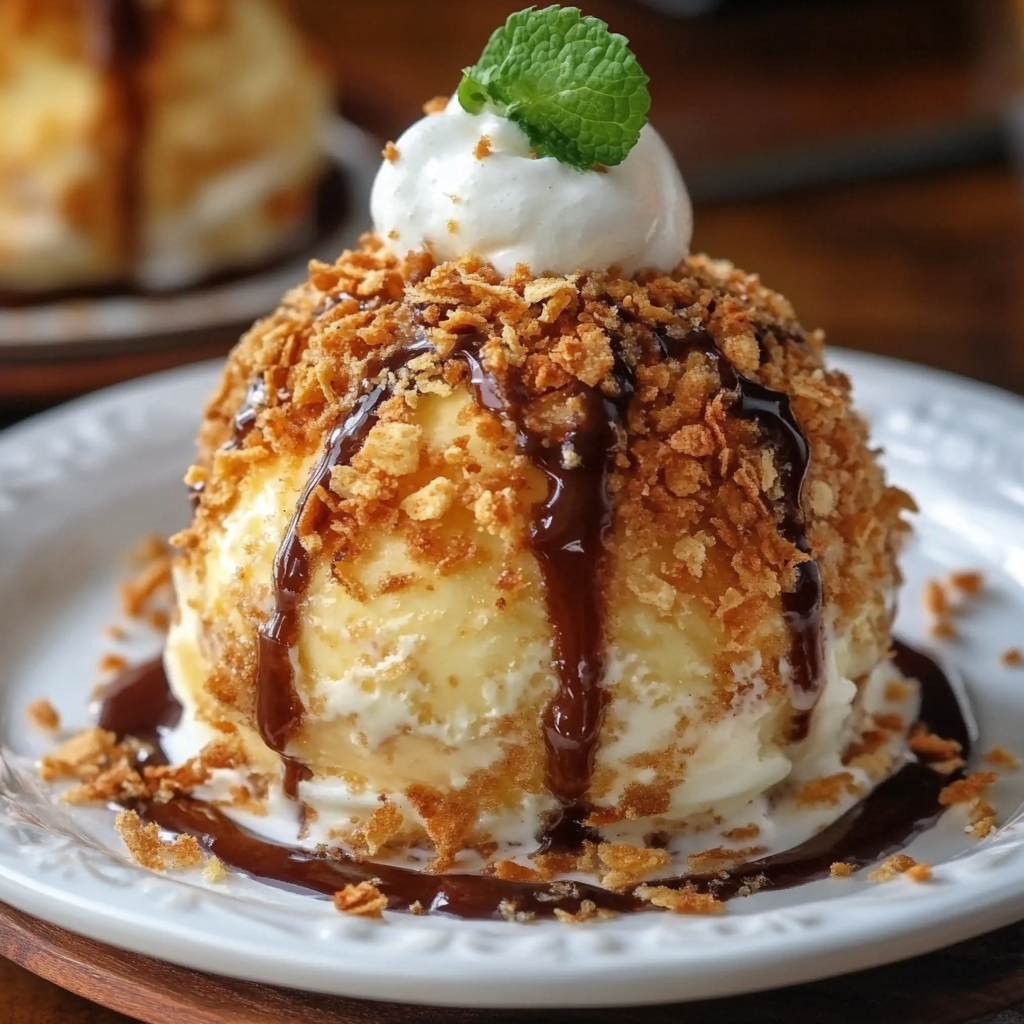
Variations of Mexican Fried Ice Cream
One of the best things about Mexican Fried Ice Cream is its versatility. While the classic version features vanilla ice cream and a crushed cornflake coating, there are many delicious variations to explore. Whether you want to experiment with different flavors, coatings, or cooking methods, these creative twists will take your fried ice cream to the next level.
1. Different Ice Cream Flavors
Although vanilla ice cream is the most traditional choice, other flavors can add a fun and unique twist:
✔ Chocolate: For a richer, more indulgent experience.
✔ Strawberry: A fruity, refreshing option that pairs well with honey and whipped cream.
✔ Caramel Swirl: Adds a buttery sweetness that enhances the crispy coating.
✔ Coffee: A bold, slightly bitter contrast to the sweet toppings.
✔ Dulce de Leche: A traditional Mexican caramel flavor that complements the dessert perfectly.
If you love exploring ice cream flavors, check out Wikipedia: Ice Cream to learn more about how different flavors are made.
2. Alternative Coatings for Extra Crunch
While cornflakes are the classic choice, you can try these alternative coatings for a unique texture and taste:
✔ Graham Crackers: Creates a slightly sweet, cookie-like crunch.
✔ Oreo Crumbs: Perfect for chocolate lovers.
✔ Shredded Coconut: Adds a tropical twist to the dish.
✔ Panko Breadcrumbs: Common in Japanese tempura-fried ice cream, providing an ultra-crispy texture.
✔ Crushed Nuts (Almonds, Pecans, or Peanuts): Adds a nutty depth of flavor and extra crunch.
For more creative topping ideas, check out Pinterest: Ice Cream Toppings.
3. Baking Instead of Frying
If you prefer a healthier version or want to avoid deep-frying, you can achieve a similar crispy texture by baking the coated ice cream balls instead.
✔ Preheat the oven to 450°F (230°C).
✔ Place the coated ice cream balls on a lined baking sheet.
✔ Bake for 3-5 minutes, just until the coating turns golden brown.
✔ Serve immediately with your favorite toppings.
This method provides a crunchier, slightly drier texture but is a great alternative for those who want to avoid frying.
4. No-Fry Version: The Easiest Method
If you don’t want to deal with hot oil or baking, you can still enjoy the flavors of Mexican Fried Ice Cream by skipping the frying process entirely.
✔ Coat the ice cream balls in crushed cornflakes, graham crackers, or Oreos.
✔ Press the coating firmly to ensure it sticks.
✔ Drizzle with honey or chocolate syrup and top with whipped cream.
✔ Freeze for another 30 minutes before serving for the best texture.
This version is great for kids or anyone who wants a quick and mess-free alternative to traditional fried ice cream.
Looking for more easy, no-fry desserts? Check out Pinterest: No-Fry Dessert Recipes.
5. Adding Spices for a Flavor Boost
For those who love experimenting with flavors, adding spices to the coating can enhance the taste:
✔ Nutmeg: Pairs well with cinnamon for a warm, spiced flavor.
✔ Cayenne Pepper: Adds a hint of heat that contrasts beautifully with the sweet ice cream.
✔ Pumpkin Spice: Perfect for a fall-inspired twist.
✔ Chili Powder: For a subtle Mexican heat that elevates the dessert’s flavor.
Spices can be mixed directly into the cornflake coating or sprinkled over the finished dessert for an extra flavor boost.
With so many variations to try, Mexican Fried Ice Cream can be customized to suit any taste preference. Whether you stick with the classic version or experiment with new flavors, this dessert remains a delicious, crowd-pleasing treat!
Tips for Perfect Fried Ice Cream
Making Mexican Fried Ice Cream at home might seem challenging, but with the right techniques, you can achieve the perfect balance of crispy coating and frozen, creamy interior. Follow these expert tips to avoid common mistakes and ensure your dessert turns out deliciously golden and crunchy every time.
1. How to Prevent Ice Cream from Melting Too Quickly
✔ Freeze the ice cream balls for at least 1 hour before coating.
✔ After coating, freeze them again for another 30 minutes to 1 hour.
✔ Keep the ice cream balls as cold as possible before frying.
The longer you freeze the ice cream before frying, the less likely it is to melt. If possible, freeze the coated ice cream overnight for best results.
For more insights into how freezing works, check out Wikipedia: Ice Cream.
2. Getting the Crispiest Coating
✔ Crush the cornflakes finely so they stick better to the ice cream.
✔ Press the coating firmly onto the ice cream balls to create a solid crust.
✔ Double coat the ice cream balls for extra crunch—dip in the coating, freeze, and repeat the process.
A thick, well-adhered coating acts as a barrier, protecting the ice cream from melting when exposed to hot oil.
3. Maintaining the Right Oil Temperature
✔ Heat the oil to exactly 375°F (190°C).
✔ Use a kitchen thermometer to monitor the temperature.
✔ Avoid frying multiple ice cream balls at once, as this can lower the oil’s temperature.
If the oil is too hot, the coating may burn before fully crisping. If it’s too cold, the ice cream may start melting before the coating is fried properly. Learn more about deep-frying techniques at Wikipedia: Deep Frying.
4. Frying for Just the Right Amount of Time
✔ Fry each ice cream ball for only 5-10 seconds.
✔ Use a slotted spoon to remove it immediately once golden brown.
✔ Drain excess oil on a paper towel to keep the coating crispy.
Flash-frying is key—just a few extra seconds can cause the ice cream to start melting inside the coating.
5. Mistakes to Avoid
🚫 Not freezing long enough: Ice cream that isn’t frozen solid will melt too quickly when fried.
🚫 Using large cereal pieces: If the cornflakes are too big, they won’t stick well, creating an uneven coating.
🚫 Frying too long: The outer crust burns, and the ice cream inside becomes too soft.
🚫 Using the wrong oil: Oils with low smoke points (like olive oil) can burn quickly, ruining the dessert’s flavor.
Serving Suggestions & Pairings
Once you’ve mastered the art of making Mexican Fried Ice Cream, the next step is to present it beautifully and pair it with complementary flavors. A well-plated dessert enhances the dining experience, while the right accompaniments can elevate the flavors of this indulgent treat.
1. Best Ways to Serve Mexican Fried Ice Cream
✔ Classic Presentation: Serve each fried ice cream ball in a shallow dessert bowl or plate. Drizzle with honey or chocolate syrup, add a dollop of whipped cream, and top with a maraschino cherry.
✔ Taco-Inspired Dessert: Serve the ice cream in a cinnamon-sugar tortilla bowl for a fun, Mexican-inspired twist.
✔ Mini Portions: Make smaller, bite-sized fried ice cream balls for an easy-to-share dessert platter.
✔ Restaurant-Style Plating: Use a drizzle of caramel or raspberry sauce on the plate before placing the fried ice cream on top for a gourmet touch.
For inspiration on plating techniques, check out Pinterest: Mexican Desserts.
2. Toppings to Enhance the Flavor
While honey, chocolate syrup, whipped cream, and cherries are the most common toppings, you can experiment with different flavors and textures:
✔ Caramel sauce – Adds a buttery richness.
✔ Crushed nuts (almonds, pecans, or peanuts) – Provides extra crunch.
✔ Fresh fruit (strawberries, bananas, or mango slices) – Balances the sweetness with natural acidity.
✔ Coconut flakes – A tropical twist that pairs well with chocolate drizzle.
✔ Sprinkles – A colorful and festive addition, perfect for celebrations.
For more topping ideas, visit Pinterest: Ice Cream Toppings.
3. Perfect Pairings for Mexican Fried Ice Cream
Pairing fried ice cream with other Mexican-inspired treats and drinks can turn a simple dessert into a full Tex-Mex feast. Here are some delicious pairings:
✔ With Churros: The cinnamon-sugar crunch of churros complements the crispy coating of fried ice cream.
✔ With Mexican Hot Chocolate: A warm, spiced hot chocolate enhances the dessert’s sweetness.
✔ With Horchata: This Mexican rice milk drink with cinnamon and vanilla pairs beautifully with fried ice cream.
✔ With Sopapillas: These puffed, fried pastries drizzled with honey make a great accompaniment.
For more about traditional Mexican sweets, visit Wikipedia: Mexican Cuisine.
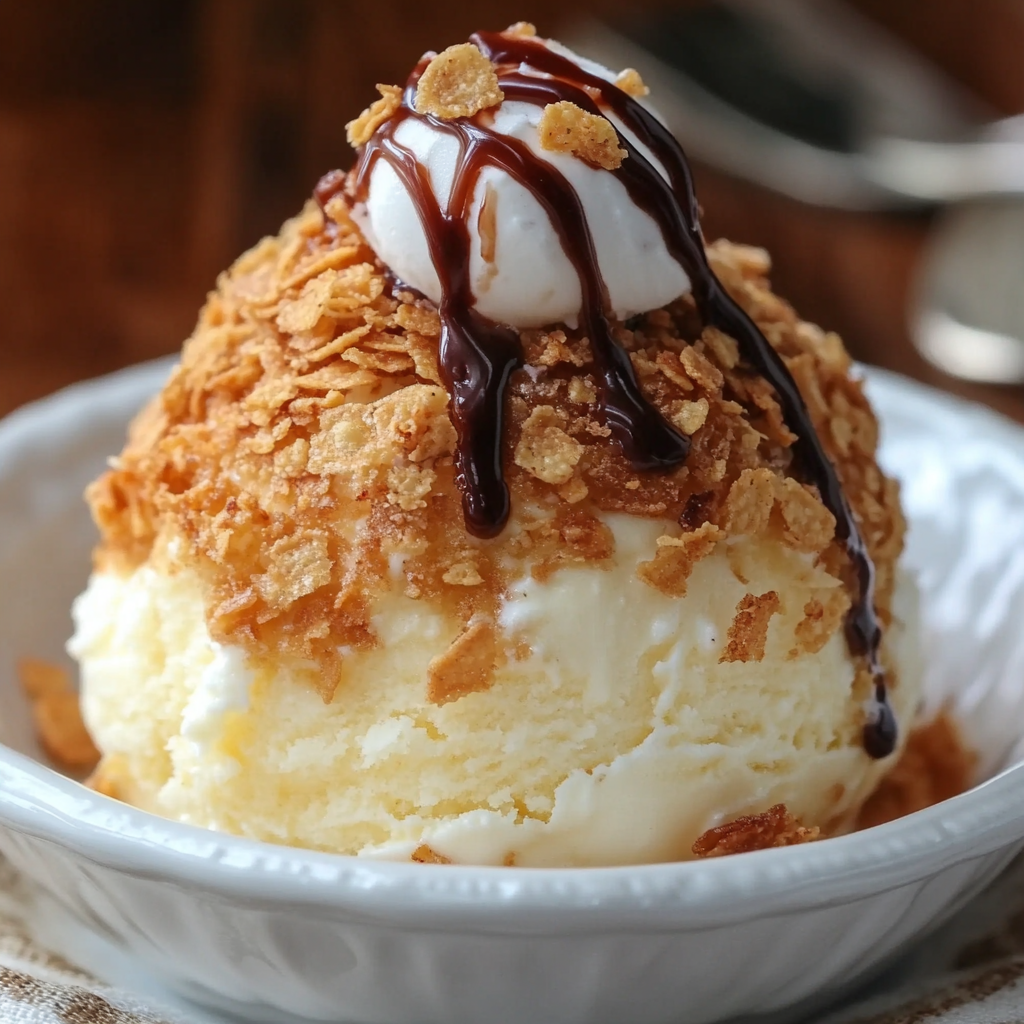
FAQs
Many people have questions about making Mexican Fried Ice Cream, especially when trying it at home for the first time. Here are answers to the most commonly asked questions to help you perfect this delicious dessert.
1. Is Mexican Fried Ice Cream Actually Mexican?
Despite its name, Mexican Fried Ice Cream isn’t originally from Mexico. The dessert became popular in the U.S. through Tex-Mex restaurants, especially Chi-Chi’s in the 1980s. However, its use of cinnamon, honey, and crunchy coatings resembles traditional Mexican sweets, which helped reinforce the association with Mexican cuisine.
For more information on the history of fried ice cream, visit Wikipedia: Fried Ice Cream.
2. Can I Make Fried Ice Cream Without Frying?
Yes! If you want to skip frying, try a no-fry version:
✔ Coat the ice cream in crushed cornflakes, graham crackers, or Oreos.
✔ Press the coating firmly to ensure it sticks.
✔ Freeze for at least 30 minutes before serving.
✔ Drizzle with honey or chocolate syrup and add toppings.
For more no-fry dessert ideas, check out Pinterest: No-Fry Dessert Recipes.
3. What’s the Best Way to Keep Ice Cream from Melting?
✔ Freeze the ice cream balls for at least 1 hour before coating.
✔ After coating, freeze them again for 30 minutes to 1 hour.
✔ Work quickly when frying—only 5-10 seconds per ice cream ball.
✔ Serve immediately after frying to maintain the perfect texture.
4. Can I Prepare Fried Ice Cream Ahead of Time?
Yes! To save time, you can:
✔ Coat and freeze the ice cream balls up to 24 hours in advance.
✔ Store them in an airtight container to prevent freezer burn.
✔ Fry them just before serving for the best texture.
5. What Are the Best Toppings for Mexican Fried Ice Cream?
✔ Honey or chocolate syrup – The most classic choices.
✔ Caramel drizzle – Adds a rich, buttery flavor.
✔ Whipped cream & maraschino cherries – A must for presentation.
✔ Crushed nuts, coconut flakes, or sprinkles – For extra crunch.
✔ Fresh fruit (strawberries, bananas, mangoes) – Balances the sweetness.
For more topping inspiration, visit Pinterest: Ice Cream Toppings.
6. Can I Use a Different Cereal for the Coating?
Absolutely! While cornflakes are the traditional choice, you can use:
✔ Graham cracker crumbs – Adds a slight cookie flavor.
✔ Crushed Oreos – Perfect for chocolate lovers.
✔ Panko breadcrumbs – Extra crispy, used in Japanese tempura-fried ice cream.
✔ Shredded coconut – A tropical variation.
7. What’s the Best Oil for Frying Ice Cream?
✔ Vegetable oil – Neutral flavor and high smoke point.
✔ Canola oil – Light texture, ideal for frying desserts.
✔ Peanut oil – Adds a slightly nutty taste (avoid if there are allergies).
The oil should be heated to 375°F (190°C) to ensure quick frying. Learn more about deep-frying methods at Wikipedia: Deep Frying.
PrintMexican Fried Ice Cream
A fiesta for your taste buds! This dessert features a scoop of creamy vanilla ice cream encased in a crispy, cinnamon-sugar coating, deep-fried to perfection, and topped with whipped cream, chocolate drizzle, and a cherry.
- Author: Clara
Ingredients
For the ice cream balls:
- 4 scoops vanilla ice cream
- 2 cups cornflakes, crushed
- 1 tsp cinnamon
- 2 tbsp granulated sugar
For frying:
- 2 cups vegetable oil
For topping:
- Honey or chocolate syrup
- Whipped cream
- Maraschino cherries
Instructions
Scoop four balls of vanilla ice cream and place them on a baking sheet. Freeze for at least 1 hour until firm.
In a bowl, mix crushed cornflakes, cinnamon, and sugar.
Roll each frozen ice cream ball in the cornflake mixture, pressing gently to coat evenly. Place them back in the freezer for another 30 minutes.
Heat vegetable oil in a deep pan to 375°F (190°C).
Quickly fry each ice cream ball for 5-10 seconds until golden brown. Remove with a slotted spoon and place on a paper towel to drain excess oil.
Drizzle with honey or chocolate syrup, top with whipped cream, and garnish with a cherry. Serve immediately.
Notes
- Freeze the ice cream balls well before frying to ensure they hold their shape.
- Experiment with different toppings like caramel sauce, sprinkles, or crushed nuts.
- For a non-fried version, roll the ice cream balls in crushed cereal and freeze until firm.
